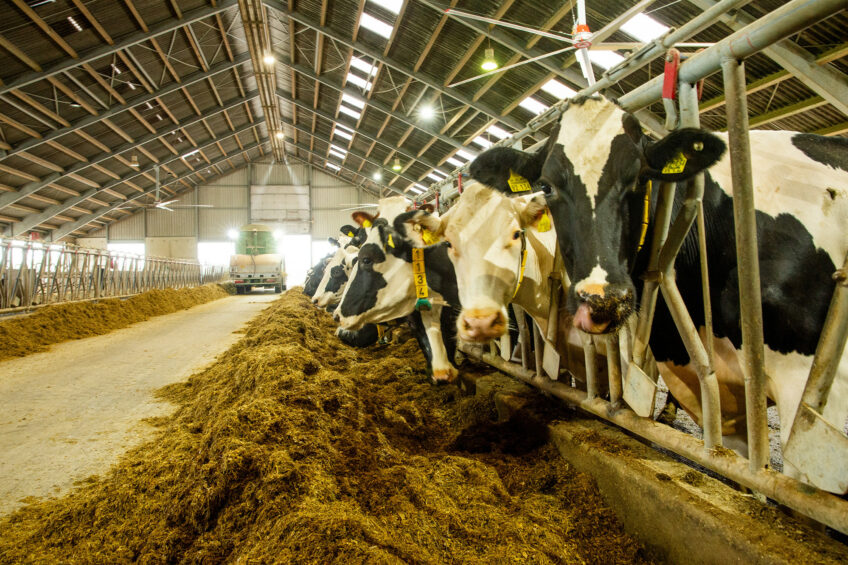Impact of diet on epigenetic alteration of mammary gland in dairy cows

This article will discuss the epigenetic modification process in dairy cows and the impact of nutrients on epigenetic modification of mammary gland.
In dairy cattle, epigenetic alterations are defined as the changes in gene expression caused by DNA or protein modifications. Epigenetic alterations including DNA methylation, histone modification and small non-coding RNAs are influenced by nutrition in both dairy cows and their offspring. Therefore, optimising the dairy cow diet can promote beneficial epigenetic modifications such as improvement in milk production and quality.
Epigenetic modification process in dairy cattle
DNA methylation
DNA methylation is an epigenetic modification process which is involved in development, differentiation, and genomic stability. During this process, methyl groups are added to the DNA molecule using the following 3 conserved enzyme families:
- DNA methyltransferase 1,
- DNA methyltransferase 3a, and
- DNA methyltransferase 3b.
The DNA methyltransferase 1 maintains DNA methylation patterns during DNA replication and ensures faithful transmission of methylation patterns to daughter cells. Both DNA methyltransferase 3a and 3b establish new DNA methylation patterns during development and cellular differentiation. These enzymes need a methyl donor such as choline, betaine, methyl-folate, or methionine obtained from the diet for proper function.
Studies have shown that lack of methyl donors in dairy cow diet leads to hypomethylation in the offspring, thus affecting birth weight, immune function, and blood pressure levels.
Histone modifications
Histone modifications are defined as chemical alterations occurring in the histone proteins which are the main components of chromatin. Histone modification including acetylation, phosphorylation, and methylation regulates gene expression, chromatin structure, and DNA replication, repair, and transcription. Histone acetylation is regulated by modifying lysine residues of histone using histone acetyltransferases and histone deacetylases enzymes. Histone phosphorylation occurs on serine, threonine, and tyrosine with kinases and phosphatases. Furthermore, histone methylation occurs on lysine and arginine side chains and is regulated by methylases and demethylases.
Small non-coding RNAs
Small non-coding RNAs or micro RNAs are transcribed from cell DNA in the cell nucleus. Micro RNAs are about 20–24 nucleotides in length that do not code for proteins, and they are involved in development, cell proliferation, differentiation, and apoptosis. Micro RNAs bind to mRNA molecules, which results in mRNA degradation or translation inhibition into proteins, thus regulating gene expression. Primary micro RNAs synthesized in cell nucleus are processed by an enzyme called Drosha to form precursor micro RNAs which are exported to the cytoplasm. Then the precursor micro RNAs are processed by an enzyme called Dicer and create mature micro RNAs. Other non-coding RNAs with epigenetic regulatory characteristics include Piwi-interacting RNA (piRNA), small interfering RNA (siRNA), small nucleolar RNA (snoRNA), circular RNAs (circRNAs), and long non-coding RNAs (lncRNAs). Although the exact connection between nutrition and the regulation of these non-coding RNAs remains unknown.
Nutrients affecting DNA methylation
DNA methylation is a key epigenetic mechanism involved in milk production which is related to the protein and fat levels in milk. Research has shown that dairy cow nutrition affects epigenetic regulation in the mammary gland, thus changing milk quality and quantity. Protein restriction in dairy cow diet during pregnancy and lactation changes the expression of genes involved in milk production and the pattern of DNA methylation in the mammary gland of offspring.
In addition, the presence of choline, betaine, and folic acid alters DNA methylation patterns and gene expression in the mammary gland. Dietary supplementation of methionine during the peripartum period increases phosphorylation of the antioxidant transcription regulator, decreases the abundance of its negative regulator in mammary tissue, and upregulates the expression of genes related to milk protein and fat synthesis.
Furthermore, methionine supplementation increases the expression of phosphatidylethanolamine methyltransferase and cystathionine β-synthase, resulting in a higher synthesis of antioxidants. Moreover, providing a post-ruminal supply of choline during dry period improves liver fatty acid metabolism which in turn impacts milk composition .
Nutrients affecting histone modification
Histone modifications which play a role in milk production can also be influenced by nutrition. Dietary supplementation of polyphenols and omega-3 fatty acids alters histone acetylation patterns in the mammary gland, thus resulting in modified gene expression and milk composition.
Adding carbohydrates to dairy cow diet enhances the availability of glucose used by the mammary gland for milk production and milk protein synthesis. Although excessive carbohydrate and energy intake will result in an imbalance in metabolism, and fatty acid accumulation in liver which in turn alter the histone modification patterns of genes related to fatty acid biosynthesis and decreases the milk fat content and milk yield.
Nutrient affecting small non-coding RNAs
Small non-coding RNAs that modify gene expression during pregnancy and lactation can be influenced by dairy cow diet. Small non-coding RNAs suppress the translation of target genes by binding to complementary sequences in the untranslated regions of mRNAs which degrade or inhibit translation. Studies have shown that lactalbumin content and dietary fat composition affect the small non-coding RNAs expression in dairy cow mammary gland.
* Reference is available upon request.






